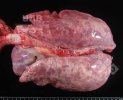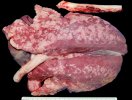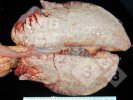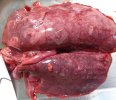Porcine respiratory coronavirus
Porcine respiratory coronavirus is usually not of clinical importance, but seems to produce antibodies that protect against viral transmissible gastroenteritis.
Alternative names: Porcine respiratory coronavirus infection
Information
This infection first appeared about ten years ago or more in Europe. Porcine respiratory coronavirus is related to, but different from, the transmissible gastroenteritis virus, which also belongs to the coronavirus family. It is believed that due to airborne transmission between farms, it is very difficult to keep farms free of the virus. Infection often occurs in nursing piglets at 2 - 3 weeks of age, although it is not significant. When other respiratory pathogens are present on farms with chronic respiratory problems, it can have an effect on lung tissue.
Symptoms
All ages
- Typically it does not produce symptoms.
- It may be associated with a cough if other respiratory pathogens are present.
Causes / Contributing Factors
- Field-level observations indicate that the virus travels airborne across long distances .
- It is spread via the respiratory tract.
Diagnosis
Coronavirus infection cross-reacts with transmissible gastroenteritis in standard serological tests and may therefore mislead the diagnosis. There is a test that distinguishes between the two but some recent results have been positive, indicating a new virus or altered strain of transmissible gastroenteritis.
Control/Prevention
- There is no specific treatment.
- If necessary, broad-spectrum antibiotics should be used in feed, water or given by injection.
Atlas of pathology
See images in the Altlas related to Porcine respiratory coronavirus






